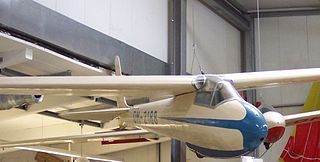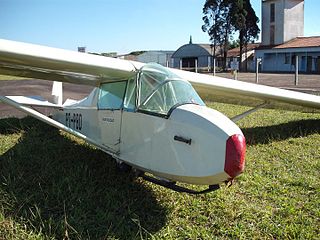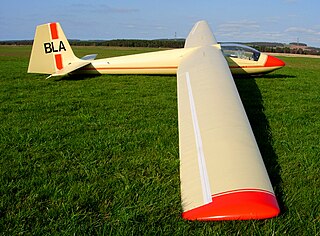
The DFS Olympia Meise was a German sailplane designed by the Deutsche Forschungsanstalt für Segelflug (DFS) for Olympic competition, based on the DFS Meise.

The Schleicher K 8 is a single-seat glider designed by Rudolf Kaiser and built by the Alexander Schleicher company of Germany.

The Aer-Pegaso M-100 was a single-seat glider designed and built in Italy from 1967.

The Antonov A-13 was a Soviet aerobatic sailplane flown in the 1950s and 1960s. It was a small, single-seat, all-metal aircraft developed from the A-11 which could optionally be fitted with that aircraft's longer-span wings. It was a mid-wing monoplane with a tadpole-like fuselage and a V-tail.
The Schneider ES-59 Arrow is a sailplane designed and manufactured in Adelaide, South Australia in the early 1960s. The Arrow was manufactured with a one-piece wing of 13.23 metres span. It was the first Australian-built sailplane to compete in the World Gliding Championships, 1963 in Argentina. The Arrow has wood/fabric wings and tail and a wood fuselage. It has a fixed main wheel and nose skid.

The Slingsby Type 42 Eagle was a two-seat glider designed in England from 1952.

The Neiva B Monitor, also designated B-2, is a Brazilian tandem two-seat glider aircraft designed and manufactured by Indústria Aeronáutica Neiva between 1945 and 1955 for primary training and general flying.

The SZD-17X Jaskółka L was a single-seat high-performance competition glider designed and built in Poland at Szybowcowy Zakład Doświadczalny in Bielsko-Biała in 1955.
The Slingsby T.25 Gull 4 is a British glider designed and built by Slingsby that first flew in 1947.
Elliotts of Newbury was a British company that became well known for manufacturing gliders.

The Slingsby Type 34 Sky is a high performance single seat competition sailplane built in the United Kingdom. It was successful in major events, particularly in the World Gliding Championships of 1952.

The Slingsby T.30 Prefect is a 1948 British modernisation of the 1932 single-seat Grunau Baby glider. About 53 were built for civil and military training purposes.

The Slingsby Type 45 Swallow was designed as a club sailplane of reasonable performance and price. One of the most successful of Slingsby's gliders in sales terms, over 100 had been built when production was ended by a 1968 factory fire.

The Slingsby T.50 Skylark 4 was a British single seat competition glider built by Slingsby Sailplanes in the early 1960s. It sold in numbers and had success at national, though not world level competition.
The Civil Aviation Department RG-1 Rohini is an Indian two-seat training sailplane of the 1960s. A high-winged wooden monoplane, with side-by-side seating;at least 107 were built.

The DFS Weihe is a German single-seat, high-wing, 18 metre wingspan, high-performance glider that was designed by Hans Jacobs in 1937-38.

The EoN 460 series are wooden single-seat standard class sailplanes, built in the UK in the 1960s. It did not have major competition success but some remain in use in 2021.
The Reinhard Cumulus is a West German high-wing, strut-braced single-seat, glider that was designed by Gerhard Reinhard for amateur construction.

The Caudron C.800, at first also known as the Epervier is a French two seat training glider, designed and first flown during World War II and put into large scale post-war production. It was the dominant basic training glider with French clubs until the 1960s and several still fly.
The UTG-1 Loudon was an intermediate glider designed and built at the University of Toronto in Canada during the late 1940s.















